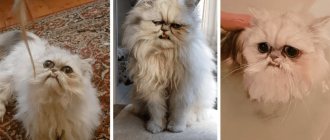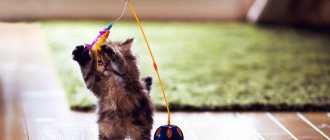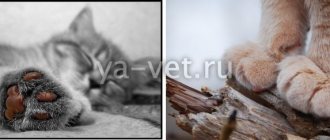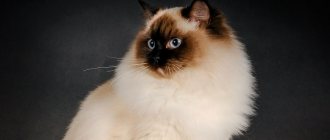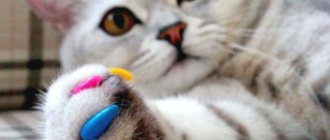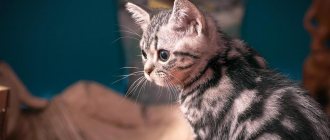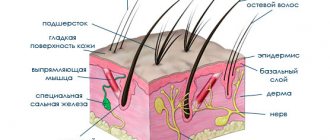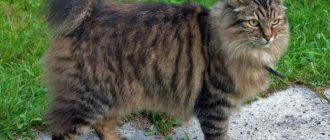177
See the TOP 10 most fluffy animals on earth with photos and descriptions! Nature has endowed them with thick hair; they are domestic and wild pets. Down is described as a soft and fluffy material, and in the case of animals it is usually, but not exclusively, fur or feathers. Fluffiness is often combined with cuteness and cuddliness, and this is where animal furry becomes a problem. The bear may be fluffy, but a real live bear is not cuddly. The marabou stork's lower feathers are the epitome of fluffiness, but marabou storks are ugly and ill-tempered, and few people would want to snuggle up to them. Even the Chow, one of the fluffiest domestic dogs, can be a little short-tempered.
It also seems that the furriest animals are domesticated and bred for maximum fluffiness and cuteness. But there are also wild furry animals. In this article we will look at a mix of furry animals, wild and domestic. These are animals that become furry as adults, as chicks and other babies often stop growing furry. Their down should also cover most of their body, with the exception of the marabou stork. Here are the 10 furriest animals:
The fluffiest animals in the world: the cuteness is off the charts
All people love animals, but furry representatives of the fauna evoke greater affection.
You want to constantly pet and hug these hairy lumps. The furriest animals in the world will melt your heart. A fluffy cow with fur like a plush toy looks very unusual.
The long-haired guinea pig requires careful care of its coat.
An albatross at an early age does not look much like an adult. He's so fluffy!
The Samoyed dog has a double coat.
Pomeranian looks like a fluffy ball. The coarse upper hair is lifted by the thick undercoat.
Chinese silky chickens are not like classic chickens. Their plumage resembles the fur of fur-bearing animals.
The fluffy fur of a Persian cat needs to be combed every day to avoid tangles.
Chinchillas are record holders for fur density: 60–80 hairs sprout from one hair follicle at once.
The giant Angora rabbit is perhaps the fluffiest of all fluffies. In Europe, these animals are quite common and are often kept as pets.
After viewing such photos, a charge of tenderness and joy is guaranteed for the whole day!
Pomeranian Spitz
At first glance, a dwarf Pomeranian spitz looks like a plush toy; it is not always possible to immediately believe that it is a living dog. Spitz have abnormally thick and long hair, which is located almost perpendicular to the body. Especially a lot of hair grows in the neck area, on the back and paws. A particularly cute feature of these dogs is their ring tail, which swings playfully from side to side.
The coat of the dwarf Spitz requires careful care; it needs to be combed 2-3 times a week with a special comb. But the dog does not need frequent washing, which is a definite plus. Particularly original owners cut their pets' hair like lions, tigers, bear cubs, foxes and other animals.
TOP 25: The cutest animals you didn't even know existed
We all have an animal that we think is cute: it might be a puppy, a kitten, or a guinea pig, but you probably don't know how many other cute animals there are in the world. From mammals to birds, there are many fascinating creatures scurrying across the earth and sky around us. Since these fuzzies are quite rare, you definitely won't find them in your backyard. Curious to see some of the cutest animals? Here are 25 cute animals you never knew about.
Photo: Pixabay.com
This tiny and adorable little furball is called a pika or pika. Despite the fact that the animal looks like a rodent, in fact its relatives are hares and rabbits, representatives of the order Lagomorpha. There are 29 species of pikas, and they are all cute in their own way.
Photo: Pixabay.com
Native to East Asia, the tanuki, or raccoon dog, may look like a raccoon, but these animals have more in common with wolves. Tanuki are especially popular in Japan, and it's easy to see why. Their thick, fluffy coat and appearance make them an enviable cuddler.
Photo: flickr.com
Small, nocturnal and with large eyes, the potto is a cute prosimian found in tropical forests around the world. As a rule, they are very slow, but they can nevertheless grab prey at the right moment. And their cute appearance can probably also make someone clutch their heart with emotion.
Photo: commons.wikimedia.org
Native to Africa, the jumping antelope, like pygmy antelopes, loves rocky terrain and keeps to itself. The Dutch name for these antelopes is “klipspringer,” which means “rock jumper.”
Seal pups
Surely everyone has seen seals on video. They rarely seem cute, and some particularly large and fat individuals cause fear and disgust, but their babies... And to be precise, the baby harp seal, the squirrel, is an incredibly cute and fluffy animal.
These babies look like little white lumps with black beady eyes. In fact, their fur is not white and soft at all, but transparent and hard, but this still does not make them any less attractive. Unfortunately, the babies don’t stay like this for long; after 3-4 weeks they shed their charming fur and dive into the icy waters, completely bald.
Interesting Facts
- The famous three-colored cat of Rus' is Bayun;
- The flamboyant Cardinal Richelieu kept a large number of colored favorites;
- A popular Japanese souvenir is a three-color “maneki neko” with a raised paw;
- The official animal in the US state of Maryland is the “tortoiseshell” cat;
- 99.9% with this coloration are females;
- Seals with three coat colors are infertile;
- Dilution will not work, stained coloring is a gift of nature;
- On the island of Honshu in 2007 they wanted to close the railway station. The situation was saved by a cat who was appointed boss. The cute creature greeted people, and soon the flow of passengers increased by 16%.
Belek
A living creature with snow-white fur, on its face there are expressive eyes and a funny nose - this is a squirrel. This is the name given to baby seals, which amaze with their soft cover. It is impossible to remain indifferent while looking into the incredible eyes of a polar animal.
An unusual creature is born in only three places on Earth: Canada, Norway and northern Russia. A female seal carries a single cub for almost a year - 11 months. Immediately after birth, he begins to feed on breast milk, which contains a very high percentage of fat. It is this nutrition that makes its fur unusually soft and fluffy.
The first two weeks of life, the squirrel is the most vulnerable and defenseless: it does not know how to move quickly and escape from natural enemies, so nature has provided it with a snow-white skin for protection, which camouflages the newborn against the backdrop of snow and ice. In addition, down perfectly copes with protection from the most severe frosts.
In Canada and Norway, squirrels have long been protected by law from extermination, but in Russia the main enemy is still not predatory animals, but a person armed with a club. At the moment, many environmental organizations are speaking out against this atrocity. Products made from the skin of squirrels are, without a doubt, very beautiful, but the fur wears out extremely quickly, and there is nothing to say about the brutal slaughter of these defenseless creatures with clubs. This barbaric and blasphemous method is considered unacceptable in most countries.
Arctic fox
Nature has two main mechanisms for protecting animals from the cold: the presence of fat under the skin and thick fur. Fat protection has its drawbacks, which are clearly visible when you watch the “gracefulness” of a walrus splashing along the shore. Fur, unlike fat, does not turn its owner into a hulking, clumsy creature, and mobility and speed are vital for predators forced to obtain food for themselves in the cold season.
The fast and nimble Arctic fox makes full use of the potential of the second method - preserving heat through fur. This animal is able to withstand the longest arctic winter with frosts dropping to minus 70°C in some periods.
In this animal one can observe the highest adaptation to natural living conditions. The fluffy layer not only changes its color at different times of the year, adapting to the landscape, but also selectively changes length at different times of the year. In areas of the body where the arctic fox comes into contact with the ground when sitting or lying, the undercoat becomes thicker and longer, reliably protecting the skin from frostbite and the internal organs from hypothermia. To prevent frostbite, the paw pads also have hairs on them.
During the cold winter, the Arctic fox looks like a well-fed creature, however, this effect is achieved due to the thick cover, under which hides a thin, muscular body, covered with a tried and true fur coat.
Alpaca
Alpacas are considered by many to be hairy llamas, although there are a huge number of differences between these species. Even if we compare the wool of alpacas and fur-bearing sheep, then in alpacas it is much lighter, more varied in shades (24 varieties), does not creak and has a subtle shine, which is especially valued in the manufacture of wool products.
The properties of the pile are such that even under the most extreme conditions, pellets do not form on it, so the alpaca always looks as if it had just come from a professional hairdresser. In addition, alpaca wool is seven times warmer and four times more wear-resistant than sheep wool; it does not form lanolin, which can cause allergies to woolen items, but it remains water-repellent.
A special feature of these artiodactyls is that their thick and soft fur coat performs two functions at once: at night it protects from frost, which in the homeland of alpacas can reach minus 30°, and during the day – from the bright sun, which can cause burns on the skin. It has been noticed that the younger the alpaca, the more delicate its cover; for this reason, mainly young specimens are used for the production of clothing, and older specimens are used for the production of expensive natural carpets. Albinos are the most valued because they are the least common in nature.
Ukrainian Levkoy
These exotic creatures were bred about 10 years ago in Kyiv. The Ukrainian Levkoy is the result of crossing the Don Sphynx with Scottish Fold cats. The end result was cats with the same body contours as sphinxes, but with funny downward-curved tips of their ears.
Ukrainian Levkoy
Sometimes Levkoys can be covered with light fluff on the body - this cannot be called full-fledged wool, so this fluff is called brush (translated from English as “brush”).
Samoyed
This dog breed is rightfully recognized as one of the fluffiest. Wool is characterized by the presence of two types of hairs: short and soft, and long and hard. Samoyeds need such a chic fur coat not only to protect them from frost, but also from the sun. In the summer heat, many caring owners try to cut their dog’s hair so that it doesn’t get too hot, but thereby do a “disservice”: the dense undercoat protects the animal’s skin from exposure to ultraviolet radiation and protects it from overheating, like an air layer.
A wonderful feature of the animal is that Samoyed fur is capable of self-cleaning. Even if the dog gets into the mud, after drying the crust will fall off on its own. Of course, when keeping an apartment, no one will wait for this, so combing will be required. But you can bathe this pet only once every six months to a year.
For the opportunity to pet their furry friend every day, owners have to pay for the fact that Samoyeds periodically undergo active molting. The period of undercoat change lasts about three weeks, and during this time everything in the apartment or house is covered with white wool. But these are real little things in life compared to a furry, loving and cozy Samoyed, which is so pleasant to touch and squeeze.
1 / 5 ( 1 voice )
plush cow
Breeders in the United States of America have developed a new cow hybrid that looks more like a giant fluffy toy than an animal. The appearance of this creature is incredibly cute due to its unusual coat, which cannot be compared with any representative of living nature. This cow appears to be more peaceful than any other breed because it is genetically unable to have horns. Females do not have an udder, so it is difficult to determine the sex of this cute stuffed cow.
What also gives her charm is the fact that an unusual thick coat grows on her legs, so they look even shorter, and the cow herself looks short and funny. The first representative of this hybrid was bred recently - just in 2013. A representative with a plush appearance became popular in a very short time, and many people became eager to have such a pet at home. For children, meeting a stuffed cow became love at first sight. But buying it is not so easy: fewer such copies are produced per year than customers crave, and for this reason the price per unit is measured in tens of thousands of dollars.
There is no need to expect significant milk yield from these animals, since their function is to touch and give pleasant tactile sensations. In order for the skin to be soft, it requires certain nutrition and ideal conditions. But this is not enough: the care program includes weekly bathing using special shampoos, conditioners, lotions, oils, mousses and foams. Regular drying will ruin the entire decorative effect, so the hairiest cows are dried using hair dryers and curlers. But even such difficulties do not stop people who want to be able to hug and cuddle this beautiful animal at home.
Semi-longhair group
The Angora cat is a breed of domestic cat that was created based on cats taken from the Ankara Zoo (Turkey) in the mid-20th century. However, semi-longhaired cats, brought to Europe from the ancient Byzantine city of Angora, have been known in Europe since the 16th century. Angora cats were so popular in Europe that all white or light-colored longhaired and semi-longhaired cats were called Angoras.
The Himalayan cat is a long-haired breed similar to the Persian cat, but has a color point coat and blue eyes.
Burmese cat. One legend says that these cats were kept in the Lao Tsung Temple. The Burmese longhair cat has a medium-sized body, slightly elongated, with good proportions. Wide, rounded head with a characteristic “Roman” nose and thick cheeks.
The British Longhair is a type of British Shorthair cat. Today, the British Longhair has emerged as a full-fledged variation of the British and is becoming more and more popular every day.
Maine Coon. The exact origins of the Maine Coon are unknown. It is one of the first known breeds in North America. There are several assumptions about its origin. According to one version, Maine Coons were brought to the continent by the Vikings.
The American Bobtail is a breed of short-tailed cat, bred by North American felinologists in the second half of the last century.
The Kurilian Bobtail is a naturally occurring breed of cat on the Kuril Islands. The short-tailed cat, or Japanese bobtail, has been known in Japan for a long time. Their images can be found in many medieval engravings.
The Mekong Bobtail or Thai Bobtail is a striking breed with a short and flexible tail. However, the tail is not only short, but also has a kink. It is in this brokenness that the uniqueness of the tails of Mekong bobtails lies: each tail is one and only of its kind.
The Japanese Bobtail is a medium-sized cat with an elongated, muscular body. Graceful, very elegant, with a short tail set high. At the end of the tail there is a pompom. The hind legs are much longer than the front legs.
The Neva Masquerade cat is a long-haired cat with a color-point (Siamese) color and bright blue eyes. The Neva Masquerade cat differs from the Siberian cat only in its color.
The Norwegian forest cat is one of the oldest breeds, formed on the basis of local mongrel cats and is most widespread in the countries of Northern Europe (Norway, Sweden, Finland, etc.). The breed standard was adopted in 1976.
Ragdoll. The breed originated in California, and most likely descended from Angora and Burmese cats. Ragdolls are practically not bred outside the United States. The Ragdoll gives the impression of being a large plush toy with silky fur.
The Siberian cat is the only Russian breed of aboriginal cats, on which only nature worked. And, as with all native breeds, tracing the origins of a particular breed is often impossible.
Somali cat. In the late 50s and early 60s, American and Canadian breeders who were breeding Abyssinian cats began to find one or two dark kittens with longer hair in their offspring.
The Turkish Van or Van cat is a breed of semi-longhaired cat created from a population of randomly bred cats that originated from the area around Lake Van in the Eastern Anatolia region of modern Turkey.
Tiffany is a distant relative of the Burmese cat and Persian chinchillas. This is a surprisingly heavy, strong, stocky cat of the non-European type with a short rounded head, large expressive eyes, a strong short body, strong short limbs with rather elegant paws and long, thin, silky hair with a medium amount of undercoat, forming a frill and panties.
The Highland Fold is a Scottish Fold. Long hair appeared as a result of breeding work on Scottish Folds with the involvement of Persians.
The chinchilla is one of the representatives of the Persians. This is a kind and friendly cat. She has a round and flat muzzle, neat small ears, bright emerald green eyes, and a magnificent, long, silky coat.
How to choose a kitten
If you have decided to acquire a representative of the beautiful LaPerm breed, you need to carefully choose a kitten. First of all, you need to decide whether you need a Show Champion or a curly-haired four-legged companion.
If you plan to exhibit a cat in competitions, then it is advisable to choose a kitten from a good nursery or from trusted breeders. It is useful to first consult with professional felinologists and veterinarians.
If you have to choose on your own, you need to remember the following health indicators:
- behavior: a physically and mentally healthy Laperma kitten is playful, eats well, shows interest in its surroundings and communicates with the rest of the kittens in the litter;
- appearance: you should not choose both the largest and smallest kittens from the litter. All parts of the body must be proportional, movements must be natural, light and relaxed;
- appetite: kittens eat often and a lot while growing;
- hygiene: there should be no discharge from the nose, eyes, ears and from under the tail;
- damage: in large litters, small kittens can sometimes accidentally scratch each other, this is acceptable if the wounds are superficial and isolated; however, it is better when the babies are unharmed;
- condition of the parents: in addition to examining the kittens themselves, you need to evaluate their parents - whether there are any diseases, hereditary or acquired, find out their age, what kind of litter they have.
It is worth finding out what treatments were carried out against parasites, whether any vaccinations were done, and clarify the names of the drugs that were used
It is important to know what foods cats are fed to make it easier to decide on food in the future. Also, we must not forget that Laperm’s fur does not curl immediately, but no later than until he is six months old.
Mr. Cat recommends: popular breeds
The popular recognition of the breed is influenced by completely different factors than the official one. Subspecies that are affordable, widespread, and prolific (you don’t have to wait several years for a kitten) are becoming popular.
An easy-going and friendly character and the absence of difficulties with nutrition and care play an important role.
Thanks to the combination of positive qualities and the availability of purebred kittens with documents, Turkish Angoras, Maine Coons, Persians, Siberians, Norwegian Forest cats and all subspecies of Asian longhaired cats with a characteristic Siamese color become domestic fluffies.
